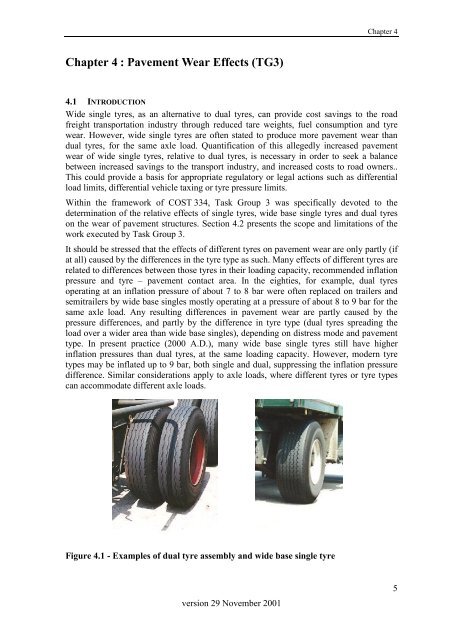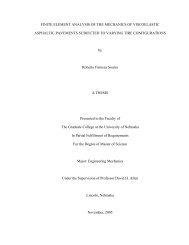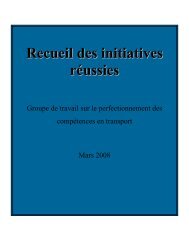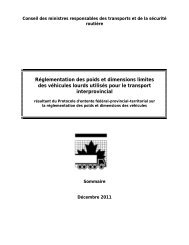You also want an ePaper? Increase the reach of your titles
YUMPU automatically turns print PDFs into web optimized ePapers that Google loves.
Chapter 4Chapter 4 : Pavement Wear Effects (TG3)4.1 INTRODUCTIONWide single tyres, as an alternative to dual tyres, can provide cost savings to the roadfreight transportation industry through reduced tare weights, fuel consumption and tyrewear. However, wide single tyres are often stated to produce more pavement wear thandual tyres, for the same axle load. Quantification of this allegedly increased pavementwear of wide single tyres, relative to dual tyres, is necessary in order to seek a balancebetween increased savings to the transport industry, and increased costs to road owners..This could provide a basis for appropriate regulatory or legal actions such as differentialload limits, differential vehicle taxing or tyre pressure limits.Within the framework of <strong>COST</strong> <strong>334</strong>, Task Group 3 was specifically devoted to thedetermination of the relative effects of single tyres, wide base single tyres and dual tyreson the wear of pavement structures. Section 4.2 presents the scope and limitations of thework executed by Task Group 3.It should be stressed that the effects of different tyres on pavement wear are only partly (ifat all) caused by the differences in the tyre type as such. Many effects of different tyres arerelated to differences between those tyres in their loading capacity, recommended inflationpressure and tyre – pavement contact area. In the eighties, for example, dual tyresoperating at an inflation pressure of about 7 to 8 bar were often replaced on trailers andsemitrailers by wide base singles mostly operating at a pressure of about 8 to 9 bar for thesame axle load. Any resulting differences in pavement wear are partly caused by thepressure differences, and partly by the difference in tyre type (dual tyres spreading theload over a wider area than wide base singles), depending on distress mode and pavementtype. In present practice (2000 A.D.), many wide base single tyres still have higherinflation pressures than dual tyres, at the same loading capacity. However, modern tyretypes may be inflated up to 9 bar, both single and dual, suppressing the inflation pressuredifference. Similar considerations apply to axle loads, where different tyres or tyre typescan accommodate different axle loads.Figure 4.1 - Examples of dual tyre assembly and wide base single tyreversion 29 November 20015






